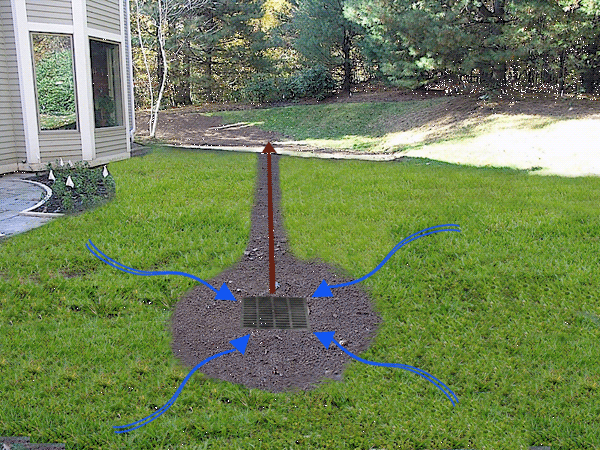Underground Gutters/French Drains
Underground Gutters/French Drains
Why is water management important?
Many people do not realize the power of water until it’s too late. As they say “water always wins” and water will usually go where it wants to go unless it is directed otherwise. Many times water can cause damage to your home even after it has been safely controlled by your gutters and downspouts. In many cases we find homes with the downspouts discharging directly next to the foundation, usually due to a downspout elbow falling off or simply because the original gutter installer didn’t know better. This water “pooling” effect next to the foundation can be a real problem, especially if the grade around the home is poor. This can lead to additional hydrostatic pressure on the foundation walls.
What is hydrostatic pressure?
Underground water creates what is known as hydrostatic pressure when it encounters a barrier such as a basement or foundation wall. During heavy rains the water table rises toward your basement which creates more hydrostatic pressure and can exert up to 500 lbs. per square inch against your home’s foundation. Over a period of time, this pressure can cause basement walls to bow or crack and lead to water in the basement, mold and a variety of other problems you don’t need. This has led to the lucrative industry of basement waterproofing which can run upwards of $10,000 or more to have installed. In most cases, this expense can be avoided if you catch it in time and invest in some outside water management options, including a functional and proper capacity gutter system and an underground drainage system.

How is underground drainage installed?
The installation of underground drainage is not usually cheap or easy – and sometimes not even possible – but is definitely the best long-term approach to directing rainwater away from the foundation. The piping used is 4″ in diameter and may be solid or corrugated. When a property has a good slope away from the home the end of the underground tile may simply be terminated and capped, however in situations without proper slope a “pop-up” drain may be needed to allow the water to exit in the middle of the lawn.

There are two main ways this drainage is installed, either by hand digging or using a commercial trenching machine. There are a number of considerations which must be made concerning underground power lines or sprinkler systems as well as cement or brick paver walk ways which will determine how the trench will be dug. Every situation is different, but in general the goal is to safely take the water as far away as possible. This can sometimes be a challenge, especially when neighbors are involved. For these reasons, we strongly recommend to our customers that when building a new home, these drain lines should be part of the building process as they will definitely be worth the investment in the long run. It is simply much more complicated to put them in “after the fact”. If you would like a professional opinion of your home’s drainage system, we offer free estimates.



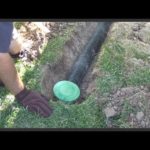
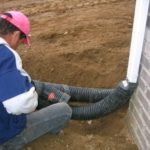
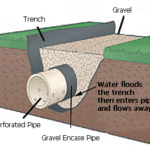
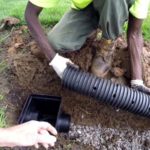

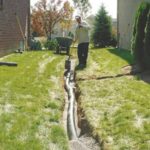
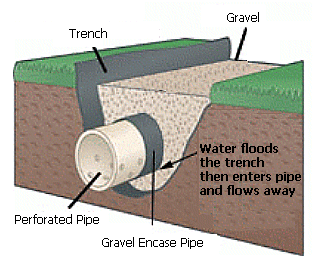
French Drains
If you have a soggy yard or a wet basement, then a French drain is your cure. Here’s how they work, when to use them, the different types and cost
Water always flows downhill, and by the easiest route possible. That’s the basic concept behind a French drain, a slightly sloped trench filled with round gravel and a pipe that diverts water away from your house.
How a French Drain Works
French drains provide an easy channel for water to flow through. Water runs into a gravel-filled trench, then into perforated pipe at the bottom of the trench. Water travels freely through the pipe, which empties a safe distance from the house. The trench bottom should be sloped about 1 inch for every 8 feet in the direction you want water to flow. Depending on your situation, the water can be diverted to:
A low-lying area of your property
A drainage ditch
A dry well
When You Need a French Drain
When you have a problem with surface water, such as a soggy lawn or a driveway that washes out
If water is getting into your basement
If you’re building a retaining wall on a hillside
If Your Problem is Surface Water
Install a shallow French drain. Also called a curtain drain, it extends horizontally across your property, directly uphill of the area you want to dry out. It intercepts water and channels it around the soggy spot.
This type of drain doesn’t have to be very deep — a common size is 2 feet deep and 1.5 feet across. Where the drain passes through areas with trees or shrubs, we switch to solid pipe (not perforated) to reduce the risk of roots growing into the piping and clogging it.

